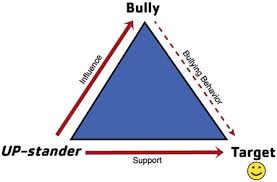 Bullying has become an issue of every day life, which has been soaring for the last few years. It is characterizing by a repeated psychological or psychical harm, which is delivered by an individual, or a group of people (bullies) and are usually targeted to an individual of less power or popularity (victims). This relationship is characterized by an imbalance of power, and it can be further distinguished by form (physical or verbal) and type (direct or indirect) (Raskauskas & Stoltz, 2007).
Bullying has become an issue of every day life, which has been soaring for the last few years. It is characterizing by a repeated psychological or psychical harm, which is delivered by an individual, or a group of people (bullies) and are usually targeted to an individual of less power or popularity (victims). This relationship is characterized by an imbalance of power, and it can be further distinguished by form (physical or verbal) and type (direct or indirect) (Raskauskas & Stoltz, 2007).
Physical bullying, for example, may involve hitting, kicking, pushing, or shoving, while verbal bullying includes teasing or name-calling. These are both examples of direct bullying, whereas indirect bullying, also known as relational aggression, is characterized by psychological attacks, such as the use of rumors or social exclusion (Espelage & Swearer, 2003; Olweus, 2001). In addition, cyberbullying, the act of using technologies such as e-mail, cell phones, or text messaging, is a direct or indirect form of bullying (Chibbaro, 2007; Raskauskas & Stoltz, 2007). For all above it can be easily understood, that this is not one innocent fight between peers and it shouldn’t be encountered as one. Bullying has far-reaching implications for children’s social and emotional adjustment, both for the bully and the one being bullied. For example being the victim of bullying has been related to a variety of internalizing problems, such as anxiety and depression, as well as academic problems and suicide : lack of sleep, eating disorders, denying on going to school, decreasing on school achievements, social exclusion, lack of confidence, self- harm, suicide. Being a bully has been associated with substance abuse, academic and adjustment problems, externalizing problems, and future delinquency and antisocial behavior (Perren & Hornung, 2005). In addition, the prevalence of students who are identifying themselves as both bullies and victims has been documented in recent studies (Raskauskas & Stoltz, 2007). These youth, who may initially face aggression from others and respond with retaliatory behaviors, face outcomes that are associated with both antisocial behavior and social and emotional difficulties (Glover, Gough, Johnson, & Cartwright, 2000; Olweus, 2001). What is beyond the attitude of observers towards this phenomenon, is crucial, as most of them tend to conceal those episodes and they may be socially exclude . Their silence usually protects the bully. So the education of students towards the intolerance of any form of violence may reduce the emerge of those episodes.
 Parents and educators are facing a challenge when it comes to prevent the appearance of violent episodes but also in educating the students on not tolerating them. Creating a safe, non stressful environment in home but also in school may help in prevention of tensions and anxiety which lend to bullying. Furthermore primary significance is the education of parents and educators in order to combat to this harmful social phenomenon. They should have the opportunity of being educated on the consequences of bullying and ways on solving them throughout educational seminars, papers, books and blocks; secondly it is important to identify the problem. Both parents and teachers ought to be alert when it comes on locating the signs for bullying. Those signs may be: a completely behavior change, a sudden decrease in school grates, isolation, melancholy, denial on going to school, brushes and ripped clothes. When bullying episodes occur there should be a direct intervention on school and familial environment. An intervention may be: play of hypothetical scenarios, where children are going to play the leading roles for the progress of stories and they also will have the chance to deeply know the two completely contrary roles. What is more it would be `beneficial for students to be educated on the affects of bullying with video viewing, and also carrying out dialogs for ways of dealing with this kind of episodes. Moreover parents and teachers ought to be always available and willing to consult but also help actively students dealing with bullying episodes. In addition all schools room should have roles who they forbid every form of violence. Those should be well- known and in a visible place for all students. Furthermore there should be given a reinforce for the right behaviors whom adults should be the first to follow in order to become role models for theirs students.
Parents and educators are facing a challenge when it comes to prevent the appearance of violent episodes but also in educating the students on not tolerating them. Creating a safe, non stressful environment in home but also in school may help in prevention of tensions and anxiety which lend to bullying. Furthermore primary significance is the education of parents and educators in order to combat to this harmful social phenomenon. They should have the opportunity of being educated on the consequences of bullying and ways on solving them throughout educational seminars, papers, books and blocks; secondly it is important to identify the problem. Both parents and teachers ought to be alert when it comes on locating the signs for bullying. Those signs may be: a completely behavior change, a sudden decrease in school grates, isolation, melancholy, denial on going to school, brushes and ripped clothes. When bullying episodes occur there should be a direct intervention on school and familial environment. An intervention may be: play of hypothetical scenarios, where children are going to play the leading roles for the progress of stories and they also will have the chance to deeply know the two completely contrary roles. What is more it would be `beneficial for students to be educated on the affects of bullying with video viewing, and also carrying out dialogs for ways of dealing with this kind of episodes. Moreover parents and teachers ought to be always available and willing to consult but also help actively students dealing with bullying episodes. In addition all schools room should have roles who they forbid every form of violence. Those should be well- known and in a visible place for all students. Furthermore there should be given a reinforce for the right behaviors whom adults should be the first to follow in order to become role models for theirs students.
If bullying episodes occur there should be made concentrations of the educational staff so that treatment strategies would be formed in order to deal with those episodes. Moreover, the communication between the school and the family is crucial when it
comes on creating a common strategy for dealing with this harmful phenomenon. The direct confrontation is critical so that bullying episodes would be prevented in future.
To conclude both families and schools communities aim to create a safe and supporting environment, which will give the opportunity to children on becoming psychologically and physically healthy adults, capable of using all of their potentials in order to benefit both themselves and the society in which they live in.
Identifying the Effects of Bullying in your children
As a parent, you might wonder if your child is being bullied. Some important signs are the following:
- come home with torn, damaged, or missing pieces of clothing, books, or other belongings
- have unexplained cuts, bruises, and scratches from fighting
- have few, if any, friends with whom he or she spends time
- seem afraid of going to school, walking to and from school, riding the school bus, or taking part in organized activities with
- peers (such as clubs or sports)
- take a long, “illogical” route when walking to or from school
- lose interest in school work or suddenly begin to do poorly in school
- appear sad, moody, teary, or depressed when he or she comes home
- complain frequently of headaches, stomachaches, or other physical problems
- have trouble sleeping or frequent bad dreams
- experience a loss of appetite
- appear anxious and suffer from low self-esteem
(http://www.violencepreventionworks.org/)
Please watch the following video:
- If you are in a bystander situation, how do you intervene?
There is an increased need for bystanders to understand that bullying behaviors at school have become issues of great importance and need to take action in order to give an effort to minimize those incidents. “Some argue that close to 50% of all bullying events stop when a bystander decides to intervene, which just further shows the importance of intervening”.(Dr. Ken Rigby)
- Don’t assume that this is a private matter between the bully and the victim.Incidents of bullying, especially those that are frequent, are often not because of personal reasons;
- Don’t use violence; is not the right way to combat bullying!It takes a lot of courage for someone to step up on behalf of a bullied person. Do not support someone who is bullied by using insults and physical violence; it won’t’ help….
- Do not get disappointed if you have already talked to the teachers and school principal and no action has taken from their side…
Take Action… Keep trying!!!!!!!!!!!
If there is a continuity of complaints to teachers and other school authorities, then there will respond if they find out that the bullying is becoming a recurrent problem.
- If you feel that this is not your responsibility to take action, then try to put your self in bullied person’s place. Just try to understand how someone who is bullied could feel… (Depressed, stressed, angry, ashamed, hurt, etc). You wouldn’t want to feel that way.
- Is exclusion from taking action the only way to respond? What if the bullies might attack you? “You should never step in to protect a bullied victim if it might also put your own safety at risk”.
Take Action!!!! TALK to someone!!!
Straightaway, go and talk to a teacher or school principal, privately and confidentially, avoiding being the next target of bullies! When you Take Action and seek help you will be a person to try to combat bullying….you will not be a bystander any more!!!!!!!!
You can share your experience in our post wall! (PADLET)






